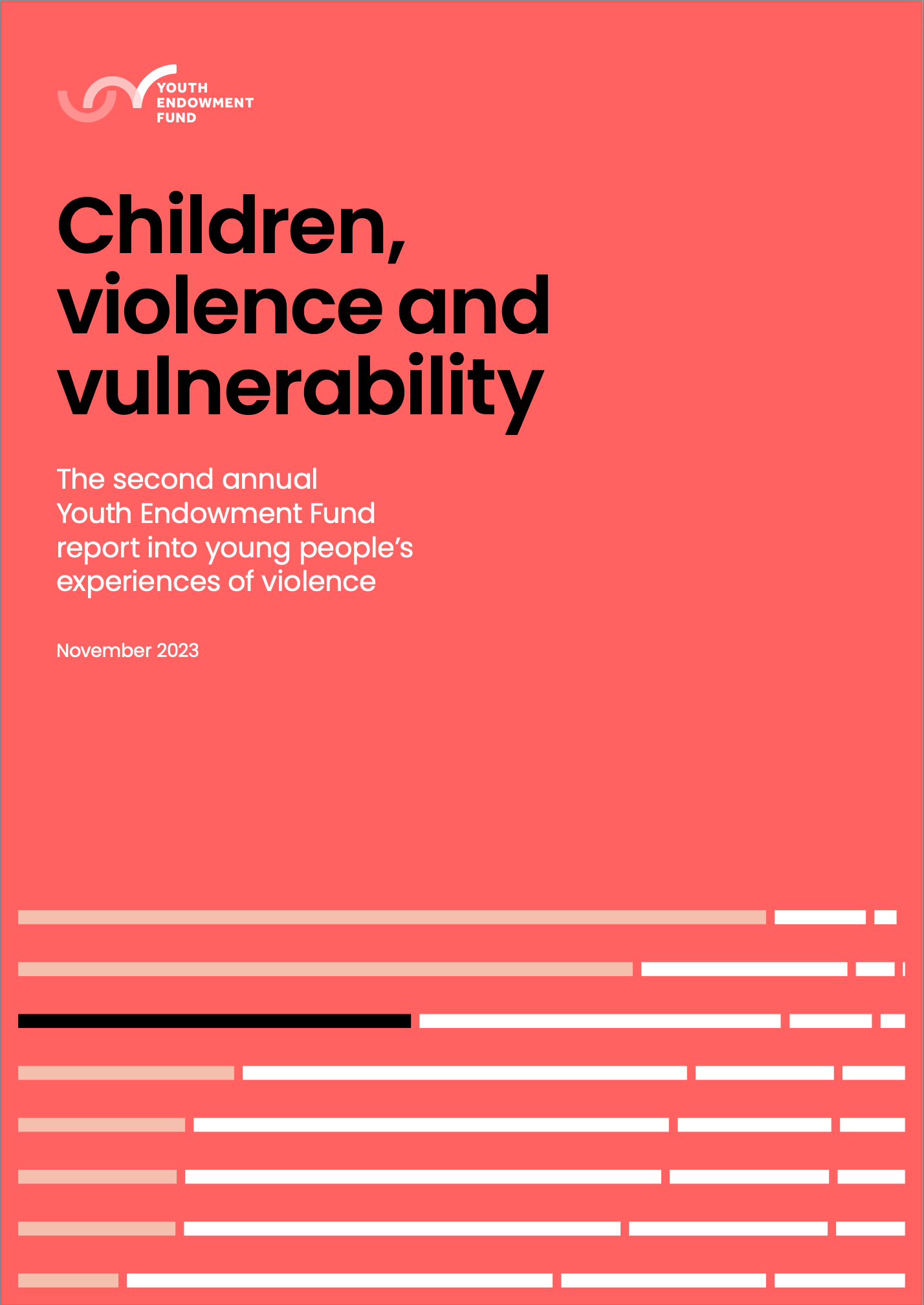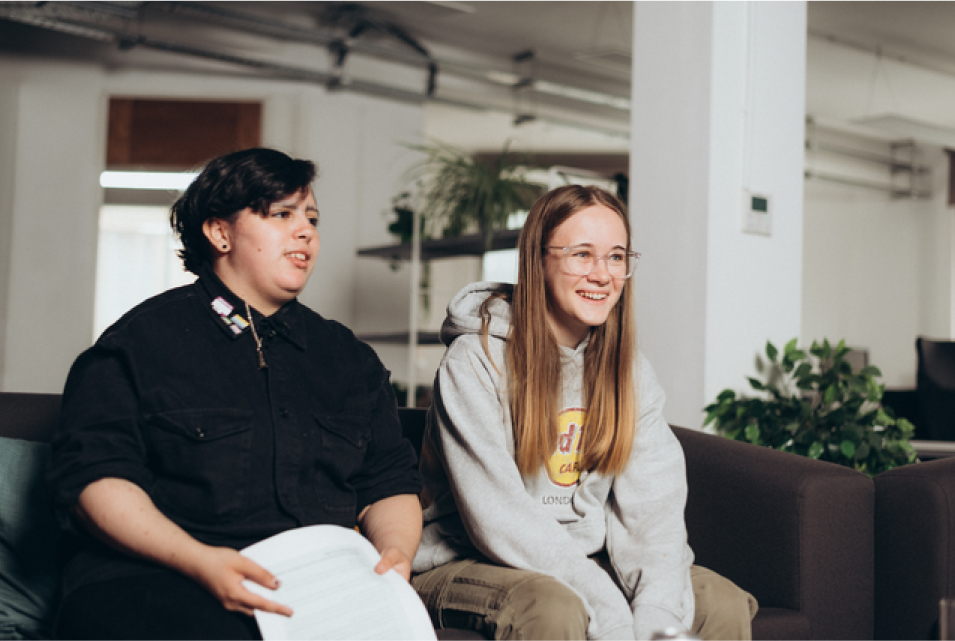Children, violence & vulnerability 2023 Summary
The second annual Youth Endowment Fund report into young people’s experiences of violence.
November 2023
Download the full report
We’re just scratching the surface.
Download a free copy of the full report for detailed findings on:
- The impact on victims of violence and how it affects their behaviour
- Visibility of violence on social media
- Drivers and solutions of youth violence
- Thoughts from our Youth Advisory Board
Foreword
1: A minority of children are either victims or perpetrators of violence
16%
of children were victims of violence in the past 12 months.
The children, violence and vulnerability report is based on our survey of 7,574 teenage children, 16% said they had been a victim of violence in the past 12 months. Among these victims, 68% experienced some form of physical injury as a result – equivalent to 360,000 13 to 17-year-old children in England and Wales. Even more (44%) had said they’d witnessed violence in the past 12-months. Nearly half (47%) saying that they’d either been a victim or witness to violence within the last year.
The findings didn’t come as a surprise to members of our Youth Advisory Board (YAB), many of whom had been affected by violence in some way.
You’re exposed to violence from a very young age. And you grow up in survival mode… You’re ready at all times. So, I really resonate with that.
Jibril, Youth Advisory Board
Download the full report

Download a free copy of the full report for detailed findings on:
- The impact on victims of violence and how it affects their behaviour
- Visibility of violence on social media
- Drivers and solutions of youth violence
- Thoughts from our Youth Advisory Board
2: Youth violence is not evenly distributed
There’s significant variation across the country, with a quarter of children in London saying they’d been a victim of violence, compared to just over one in 10 in the South East.
Violence victimisation rates of teenage children – by region
Violence victimisation – by gender
While boys were more likely to be both victims and perpetrators of violence, our findings also brought to light the prevalence of violence in girls’ lives, too. Among the teenage girls surveyed, 15% reported being victims of violence, slightly lower than the 18% reported by boys. However, girls experienced a higher incidence of sexual assault – at 7%, compared to 5% for boys. Despite lower rates of perpetration among girls, 6% still said they’d committed some form of violence that led to physical injury, compared to 9% for boys.
Violence victimisation – by race
While the majority of violence was committed by White children (70%) and the majority of victims were White (72%), Black teenage children were, on average, more likely to be vulnerable as both victims (21%) and perpetrators (22%) compared to White children (16% and 14%, respectively).
Violence victimisation – vulnerable young people
Experiences of violence were also heavily concentrated among children more vulnerable to crime and exploitation. While just 15% of respondents had ever been supported by a social worker, 37% of those had been victims and 38% had been perpetrators of violence. Similarly, children who’d used drugs (13% of respondents) and who had regularly missed school (8% of respondents) were more than twice as likely to be victims or perpetrators compared to the average. The difference was greatest for those affiliated with gangs, who had carried a weapon or had contact with the police about an offence they were suspected of – they only represented 3–5% of the total sample, but they were four to five times more likely to be victims or perpetrators compared to the average.
While most teenage children lived in households that had made changes in the past year to save money (95%), teenage children living in households facing some of the greatest pressures on their finances – including those now using foodbanks – were more likely to be victims of violence.
3: A substantial overlap between victims and perpetrators of violence
48%
of those who committed violence were also victims.
We make the distinction between victimisation and perpetration in our findings. However, it’s important to emphasise that they aren’t mutually exclusive groups. In fact, we found a substantial overlap – 48% of teenage children who said they’d committed violence were also victims of violence. This proportion increased to 81% for those who said they were part of a gang, 78% for those supported by a youth offending team and 64% for those receiving free school meals. Reflecting on this, YAB member Lily commented:
It says a lot about the support that we give – well
Lily, Youth Advisory Board
lack of support that we give – to people at a victim
level because they’re just going on and perpetrating.
They obviously didn’t get the right support they
needed, and it just goes around in a circle.
4: Violence – and the fear of violence – leads to behavioural changes
20%
of children say they have skipped school in the past 12 months.
For most children, school is considered a safe space – 85% said they felt either very or fairly safe at school. Yet for some children, the fear of violence, at times, keeps them away.
To better understand the link between violence and school absence, we asked children whether they had ever skipped school in the past 12 months due to feeling unsafe. One in five told us that they had, which is equivalent to 702,630 13 to 17-year-olds in England and Wales. This increased to 37% of children on free school meals, 46% of children supported by a social worker and 67% of children supported by a youth offending team.
Around half of teenage children (47%) said that violence, or the fear of violence, had affected them in some other way. Notably, 18% found it harder to concentrate at school, 19% experienced trouble sleeping and 26% expressed a tendency to isolate themselves more as a consequence of this fear. Minority ethnic children were more likely to feel these effects, with 55% of Asian, 54% of Black and 53% of mixed ethnicity children reporting impacts on their day-to-day lives, compared to 45% of White children.
Day-to-day impacts of violence
5: Places of safety
14%
said they felt very safe in or around youth clubs
We asked children where they felt safe and unsafe, and they typically felt less safe where there was less adult supervision, such as in parks, on the street or on public transport. However, being in or around youth clubs was also rated quite low in terms of where young people felt safe.
Where teenage children feel safe
To delve deeper into the safety of youth clubs, we turned to our YAB for their reflections:
6: Half of children committing violence did it because they were provoked
We wanted to explore why children committed acts of violence. To do this, we asked the 15% of teenage children who said they had committed some form of violence for the reasons why it had happened.
The most common explanation was that they felt provoked in some way. 50% said they’d been baited or threatened, 34% said it was in retaliation and 23% said it was because they’d been bullied. These reflect our earlier findings that nearly half of perpetrators have also been victims of violence. Less commonly cited reasons include gang, neighbourhood or school rivalries (16%), defending or protecting someone (21%) and struggling to control their behaviour (20%).
Why teenage children commit acts of violence
10%
received support or training to prevent violence.
When violence did occur, it went largely without consequences. 58% of perpetrators said nothing happened or no one in authority found out. Just over a third (35%) were punished by their parents and 18% by a teacher, with a smaller proportion being temporarily or permanently excluded from school (11%). In 9 out of 10 cases, when someone was injured, the perpetrator received no support or training to help prevent it happening again.
7: Violence online is hard to avoid
60%
had seen content on social media showing real world acts of violence
Nearly all teenage children (99%) said they used some form of social media. 60% of those surveyed said that in the past 12 months, they’d seen content on social media that showed real-world acts of violence, translating to around two million teenage children across England and Wales.
The most common type of content seen was footage of fights between children or young people and threats to beat up another child or group – viewed by 48% and 36% of all teenage children, respectively.
Proportion of teenage children seeing violent content on social media
TikTok was the platform where material showing real-life violence was most likely to be seen, both overall and as a proportion of its users. A third (33%) of all teenage children reported seeing violent content on TikTok, while 25% reported such experiences on Snapchat and 20% on YouTube. When examining the proportion of users of each platform exposed to this content, almost half of TikTok users (46%) had encountered violent content on the platform, surpassing the figures for other platforms: 38% for Snapchat and Telegram users, 34% for Facebook users and 27% for YouTube users.
Sharing their experiences of violence on social media, YAB explained:
Social media – gender-based violence
With increasing concerns about content that promotes gender-based violence and high-profile media reports of misogynistic “influencers”, this year we added new questions to explore the issue and examine its spread. 26% reported seeing content on social media that encouraged violence against women and girls. When asked how they found such content, only 9% said they’d actively searched for it. For the rest, it was viewed because it appeared on someone else’s profile (50%), was shared with them directly (33%) or was suggested to them by the platform they were using (27%). Numerous factors could lead to the promotion of this content through platforms’ algorithms – it might be because users share similar demographics and interests or because they’d viewed similar content in the past.
As YAB member Georgia explained, exposure to content that promotes violence against women and girls is often not an isolated incident for many young people:

The amount of times I’ve seen on social media, not necessarily someone beating up a woman or beating up a girl, but like rape threats … and in general being degrading towards women. It’s a bit like, ‘Where are you going to draw the line?!’
Georgia, Youth Advisory Board
35%
said they’d switch off all social media permanently.
8: Adults and children rate gangs as the biggest driver of violence
In this year’s report, we compare what adults and teenage children think the main drivers of violence are and which solutions would help to reduce it, and we found that their views were similar.
Gangs and youth violence was one of the most frequently raised issues – gangs were the highest-ranked driver of violence for both adults and teenage children, although slightly more adults (62%) considered them a major factor compared to children (50%).
Teenage children’s views on the drivers of violence
Solutions to prevent violence
We asked teenage children and adults whether they thought certain solutions would increase or decrease violent crime. Half of children and adults said mental health support, behaviour training or anti-bullying programmes would reduce violence. On the other hand, being excluded from school was the only intervention where more teenage children and adults thought it would actually increase violence rather than decrease it.
When it comes to teenage children’s opinions about the police, the picture is highly nuanced. While half agreed that the police kept them safe from violence, half didn’t, 11% disagreed and the rest either remained neutral or didn’t know. By comparison, 90% thought their parents kept them safe from violence, and 61% thought teachers did so. When asked about school-based solutions, police presence in schools was ranked as the third-highest solution to reducing violence. However, when put to our YAB, the appropriateness of police in schools was questioned by some.
According to Lily:
I don’t agree with it. Schools are a safe place, and to bring in someone who might not necessarily make that person feel safe, you’re taking that safe place away from that young person or child.
Lily, Youth Advisory Board
However, it was also noted that not all children have the same views of the police, nor are schools always considered safe spaces, as Krishna pointed out:
The Youth Endowment Fund is here to prevent children becoming involved in violence. In the upcoming year, we’ll be publishing a number of other research reports and resources, touching upon many of the issues raised in this report. Alongside this, we’ll continue to commission some of the most robust and innovative evaluations of violence prevention programmes ever undertaken in the UK. By learning what works and building a movement to put this knowledge into practice, together we can help every child to live a life free from violence.
Acknowledgement
We’d like to thank our survey partner walr. and members of our Youth Advisory Board, in particular Fatoumata Bayo Diba, Shaquille Cooper, Lily Moreton, Krishna Ramrakhani, Jibril Rose and Georgia Toman.
Lead contributors from the Youth Endowment Fund were Cassandra Popham and William Teager. Other contributors from the Youth Endowment Fund were Chad Hemady, Matthew Shaw and Elizabeth Yarrow.
All views expressed in this report are those of the Youth Endowment Fund.
© 2023 The Youth Endowment Fund Charitable Trust. All rights reserved. This publication contains some public sector information licensed under the Open Government Licence v3.0: www.nationalarchives.gov.uk/doc/open-government-licence/version/3
